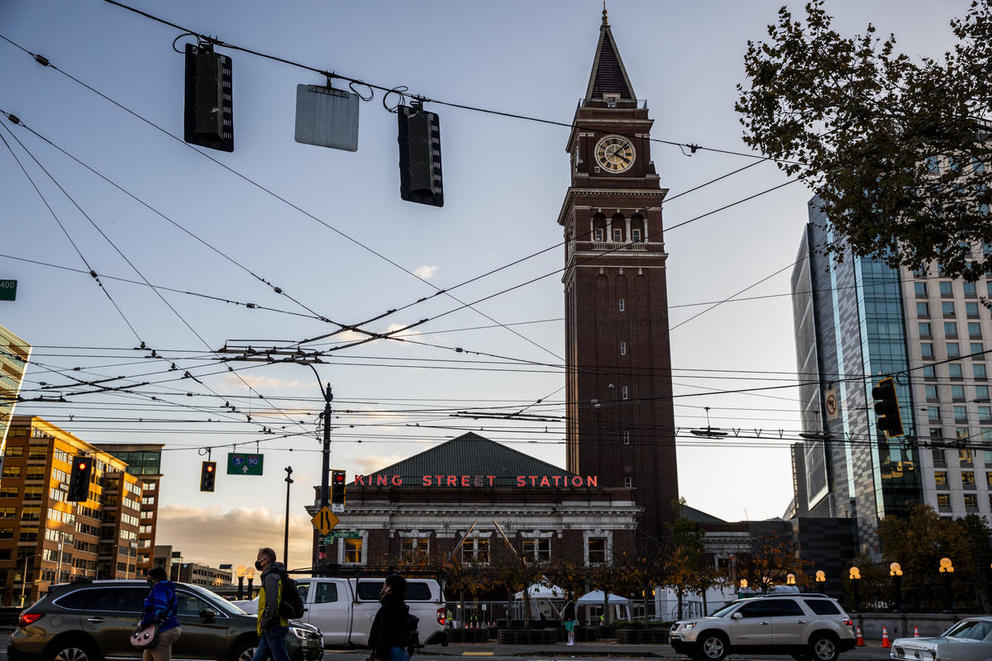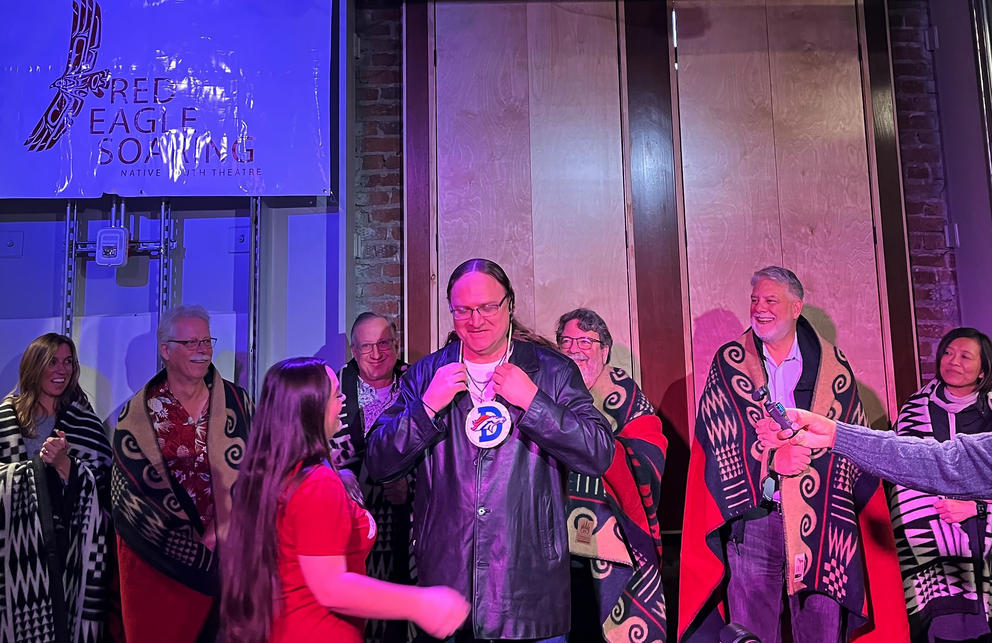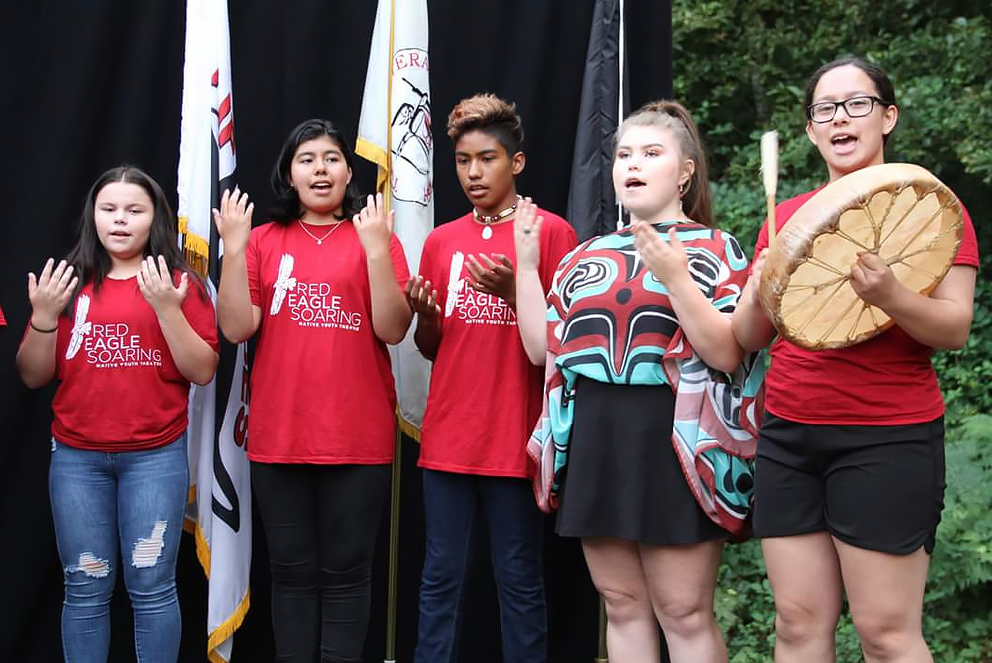With a mission to serve Native youth throughout and beyond King County, Red Eagle Soaring (or RES, pronounced “rez”) has had to be strategic about central gathering spaces. The rising cost of rent in Seattle has complicated the puzzle of securing a permanent home.
“It’s ironic that the Native youth theater, the Indigenous-facing theater, is the one that’s kind of been displaced in a city that prides itself on its artistic reputation,” said RES executive director Russell Brooks (Southern Cheyenne) in an interview with Crosscut.
But with the recent opening of Station Space, a new interdisciplinary youth arts hub at King Street Station, that’s changing.
Local public development authority Cultural Space Agency initiated the project: an 11,000-square-foot space on the second floor of the historic train station in Pioneer Square (the third floor houses the Office of Arts and Culture).
The Cultural Space Agency partnered with RES and four other youth-oriented arts organizations to bring the request to Seattle City Council. On Oct. 10 the Council cleared the way for the CSA to obtain from the Seattle Department of Transportation a 30-year lease with a 60-year option. For at least the first several years, RES and the other Station Space tenants will not have to pay rent, just utilities and their own staffing.
For the four-member staff of RES, the new space feels like a homecoming.
“We are reclaiming space for Native people on Indigenous land, and embarking on a new era of our history in which generations of Native youth will shape the trajectory of their relationships and their lives here,” Brooks said at the packed and festive Station Space opening ceremony on Nov. 11.
Like all of Seattle, the historic train station sits on Duwamish land. Before American settlers arrived, local tribes used to refer to what’s now the Pioneer Square area as the “little crossing over place,” or Dzidzilalich in the Coast Salish language of Lushootseed. In 1865, Seattle’s first city council banned Native Americans from entering the city. The King Street train station opened in 1906.
Beneath the King Street Station’s mosaic tiled floors, ornamental terracotta cornices and bronze chandeliers are the stories of a Duwamish past, which carry into the present and future. Where once Indigenous people were barred from entry, now Native youth can find safe haven for creative expression.
The new Station Space is part of the ongoing redevelopment of the transit hub, whose upstairs floors sat dormant for decades. King Street Station underwent a $50 million renovation in 2008. Just over 10 years later, the Office of Arts and Culture (aka ARTS) moved its offices to the third floor and created an expansive gallery/performance space with windows looking out toward the sports stadiums.
Nicole Suyama, artistic director of Red Eagle Soaring, gifts executive director Russell Brooks a necklace with the logo of the Denver Broncos (his favorite football team) on Nov. 11, 2023. RES and four other organizations were recently granted a 30-year lease with a 60-year option at King Street Station. (Nimra Ahmad/Crosscut)
The five youth-arts organizations that occupy Station Space — RES, Totem Star, The Rhapsody Project, Jackson Street Music Program and Whipsmart — are all part of the Office of Arts and Culture’s Creative Advantage program to increase student access to the arts.
“We know that art saves lives,” said Olisa Enrico, executive director of CSA, in an interview with Crosscut. “And that starts in the most crucial point of youth.”
“Plus,” Erin Jorgensen, digital media specialist for ARTS, wrote in an email, “it’s just fun to walk in the building and hear theater vocal warm-ups or hear drum solos coming through the floorboards.”
Around 300 people attended the grand opening and ribbon-cutting event, including homegrown rapper Sir Mix-a-Lot as the keynote speaker. (Among his other remarks, he noted, “Sixty-year lease! Impressive.”) When Enrico introduced RES director Brooks, the audience cheered loudly.
“RES as an organization has embodied the survival resiliency that our Native communities are legendary for,” Brooks said during the opening. “RES has never had a theater space of our own to call home,” he said. “To say that having this new black box-style theater workshop space in the heart of Seattle is one of the most significant events in our history would be an understatement.”
Also at the opening day ceremony, RES youth performed the finale track from their original musical Dracula Spectacular. “Like an eagle soaring above, we move forward with love, always knowing the light will lead us home,” they sang.
A creative outlet for Indigenous youth
Over its three decades, RES has worked with Indigenous youth from various tribes and backgrounds, presented almost 200 productions and performed on stages at ACT Theatre, Seattle Repertory Theatre, Intiman Theatre and The 5th Avenue Theatre. They’ve also worked closely with other local Indigenous organizations such as the Daybreak Star Indian Cultural Center.
Every year RES holds an intensive two-week summer camp that culminates in a performance. In the fall and winter, it hosts workshops — acting, filmmaking, playwriting — often led by local theater artists of Native heritage. The youth also put on a big spring production that’s free to the public (as are all of RES’s performances). The students’ age range is typically 10 to 19, with about 120 kids annually.
The original stories that RES performs are rooted in the cultures of Indigenous peoples with an eye toward contemporary social relevance. Many originate from traditional stories passed down from tribal elders and others in the Native community.
Created in-house, the plays are written by people in an RES alumni program called Yesterday, Today, Tomorrow: Urban Native Performing Artists. Youth also collaborate with the playwrights and directors to create the productions.
Several of RES’s past shows have direct connections with the Pacific Northwest. In 2011, A Right to Justice (by local teaching artists Drew Hobson, Virginia River Tribes, and Hannah Victoria Franklin) was a response to the police killing of John T. Williams (Nuu-chah-nulth) in Seattle the year before. The musical As Long as the Rivers Run (2013), by local writer and UW lecturer Roger Fernandes (Lower Elwha S’Klallam Tribe), focused on fishing rights and the importance of salmon to local tribes.
More recently, RES youth brought attention to the incidence of missing and murdered Indigenous women with the 2019 production MISSING, directed by local actor, director and producer Josephine Keefe (Nez Perce).
“Native people are the original artists and storytellers of this land and of this continent,” Brooks said. “Mainstream arts and theater are starting to notice that they need to catch up with what our Native communities have been doing.”
This past year, RES performed the more lighthearted play-turned-musical Dracula Spectacular by alum and staff member Dylan Elwood (Turtle Mountain Chippewa) and jazz vocalist Julia Keefe (Nez Perce). Two RES students — 14-year-old twin sisters Sophia and Olivia Vann (Cherokee Nation of Oklahoma), who performed at the opening — described it affectionately as “campy.”
“RES deserves this [space],” said Olivia Vann at the November 11 event. She and her sister are excited about the new location, and described the move as “reclaiming” and “decolonizing” Indigenous land.
Now soaring at King Street Station
The grand opening drew a wide swath of the RES community, with alumni including co-founder Martha Brice, now 89, and interim artistic director Nicole Suyama (Inupiaq), who has been involved with RES for approximately 20 years.
The gathered RES alumni, youth, staff and parents could be heard repeating a refrain throughout the opening — they’re reclaiming land at King Street Station.
They’re also looking forward to teaming up with new neighbors at Station Space. The five organizations share the second floor in a maze-like configuration that encourages chance encounters. “We’re likely going to be working in each other’s spaces in different capacities over time,” Brooks said.
He is eager for the opportunity for collaboration, such as with youth music organization Totem Star, whose space includes an in-house recording studio.
“We have ideas of doing cross-collaborative workshops between all of our organizations to raise our youth and their performing arts acumen,” Brooks said. “When we’re in this space, we’re going to be like one big family. So Totem Star [and] Rhapsody Project’s youth are going to be our youth, our Red Eagle Soaring youth are going to be their youth.”
The black box theater still requires some finishing touches, which Brooks said will take until the end of the year, but RES has already started rehearsing in the space.
“We’ve got some real stability,” Brooks said. “We’re going to be there for a long time to come, and there’s going to be generations of our youth that come up through that space.”
Get the latest in local arts and culture
This weekly newsletter brings arts news and cultural events straight to your inbox.





